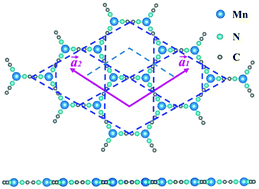Our official English website, www.x-mol.net, welcomes your feedback! (Note: you will need to create a separate account there.)
Discovery of a novel spin-polarized nodal ring in a two-dimensional HK lattice†
Nanoscale ( IF 6.7 ) Pub Date : 2018-10-16 00:00:00 , DOI: 10.1039/c8nr05383a Liang Zhang 1, 2, 3, 4 , Shu-feng Zhang 1, 2, 3, 4 , Wei-xiao Ji 1, 2, 3, 4 , Chang-wen Zhang 1, 2, 3, 4 , Ping Li 1, 2, 3, 4 , Pei-ji Wang 1, 2, 3, 4 , Sheng-shi Li 3, 4, 5, 6, 7 , Shi-shen Yan 3, 4, 5, 6, 7
Nanoscale ( IF 6.7 ) Pub Date : 2018-10-16 00:00:00 , DOI: 10.1039/c8nr05383a Liang Zhang 1, 2, 3, 4 , Shu-feng Zhang 1, 2, 3, 4 , Wei-xiao Ji 1, 2, 3, 4 , Chang-wen Zhang 1, 2, 3, 4 , Ping Li 1, 2, 3, 4 , Pei-ji Wang 1, 2, 3, 4 , Sheng-shi Li 3, 4, 5, 6, 7 , Shi-shen Yan 3, 4, 5, 6, 7
Affiliation

|
Nodal-ring materials with a spin-polarized feature have attracted intensive interest recently due to their exotic properties and potential applications in spintronics. However, such a type of two-dimensional (2D) lattice is rather rare and difficult to realize experimentally. Here, we identify the first 2D Honeycomb-Kagome (HK) lattice, Mn–Cyanogen, as a new single-spin nodal-ring material by using first-principles calculations. Mn–Cyanogen shows gapless and semiconducting properties in spin-up and spin-down orientations, respectively, indicating a spin-gapless semiconductor nature. Remarkably, a spin-polarized nodal ring induced by px,y/pz band inversion is captured from the 3D band structure, which is irrelevant to spin–orbit coupling. The origin of the single-spin nodal-ring can be further clarified by the effective tight-binding (TB) model. These results open a new avenue to achieving spin-polarized nodal-ring materials with promising applications in spintronic devices.
中文翻译:

在二维HK晶格中发现新型自旋极化的节点环†
具有自旋极化特征的节环材料由于其奇异的特性和在自旋电子学中的潜在应用,最近引起了广泛的关注。但是,这种类型的二维(2D)晶格非常罕见,并且很难通过实验实现。在这里,通过第一性原理计算,我们将第一个2D Honeycomb-Kagome(HK)晶格Mn-Cyanogen识别为一种新型的单旋结环材料。锰-氰化物分别在自旋向上和自旋向下方向上显示出无间隙和半导电特性,这表明无自旋间隙半导体性质。值得注意的是,由p x,y / p z诱导的自旋极化的节点环从3D波段结构捕获了波段反转,这与自旋轨道耦合无关。单旋结环的起源可以通过有效的紧密结合(TB)模型进一步阐明。这些结果为实现具有自旋电子器件前景的自旋极化结环材料开辟了新途径。
更新日期:2018-10-16
中文翻译:

在二维HK晶格中发现新型自旋极化的节点环†
具有自旋极化特征的节环材料由于其奇异的特性和在自旋电子学中的潜在应用,最近引起了广泛的关注。但是,这种类型的二维(2D)晶格非常罕见,并且很难通过实验实现。在这里,通过第一性原理计算,我们将第一个2D Honeycomb-Kagome(HK)晶格Mn-Cyanogen识别为一种新型的单旋结环材料。锰-氰化物分别在自旋向上和自旋向下方向上显示出无间隙和半导电特性,这表明无自旋间隙半导体性质。值得注意的是,由p x,y / p z诱导的自旋极化的节点环从3D波段结构捕获了波段反转,这与自旋轨道耦合无关。单旋结环的起源可以通过有效的紧密结合(TB)模型进一步阐明。这些结果为实现具有自旋电子器件前景的自旋极化结环材料开辟了新途径。



























 京公网安备 11010802027423号
京公网安备 11010802027423号